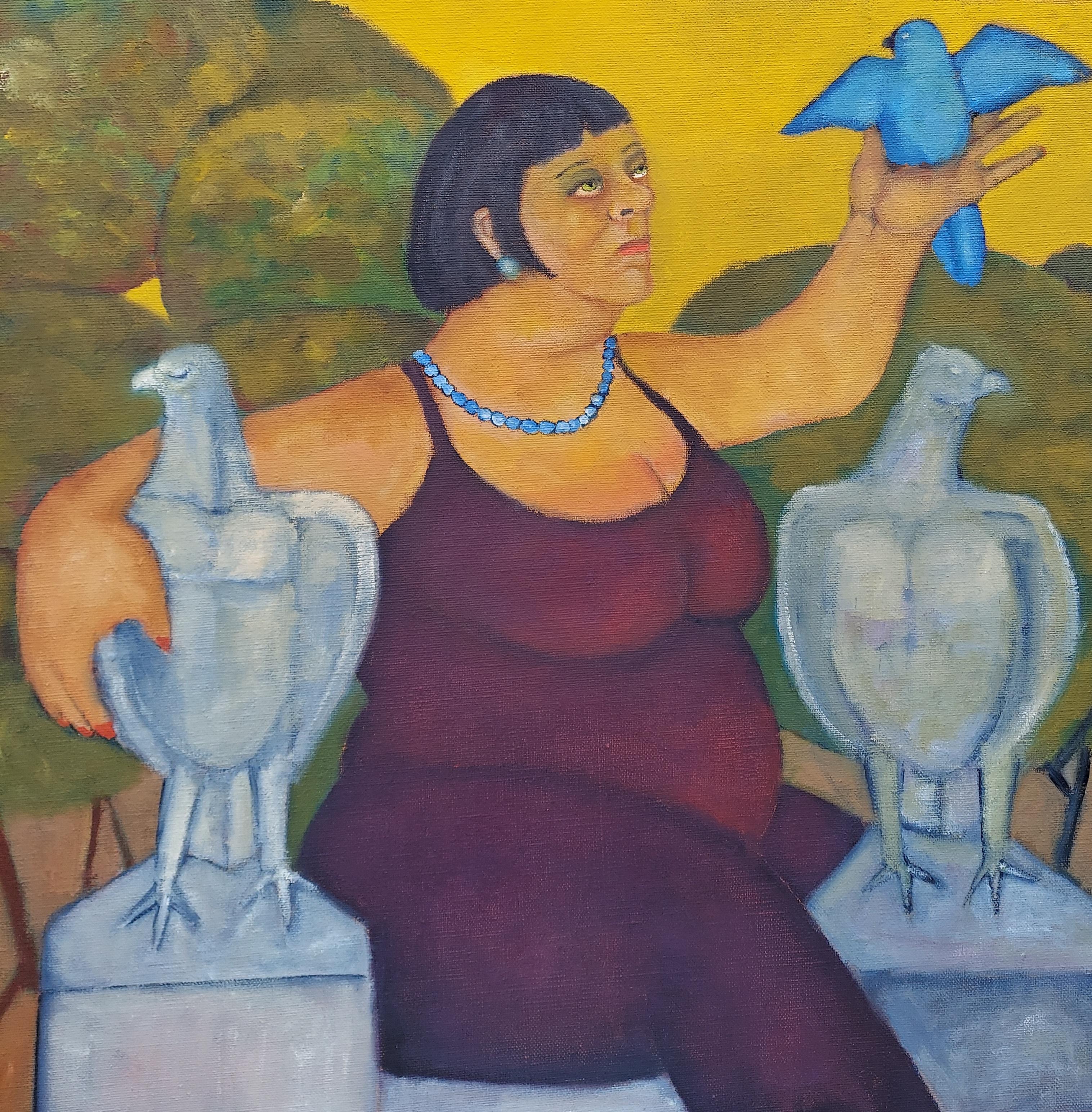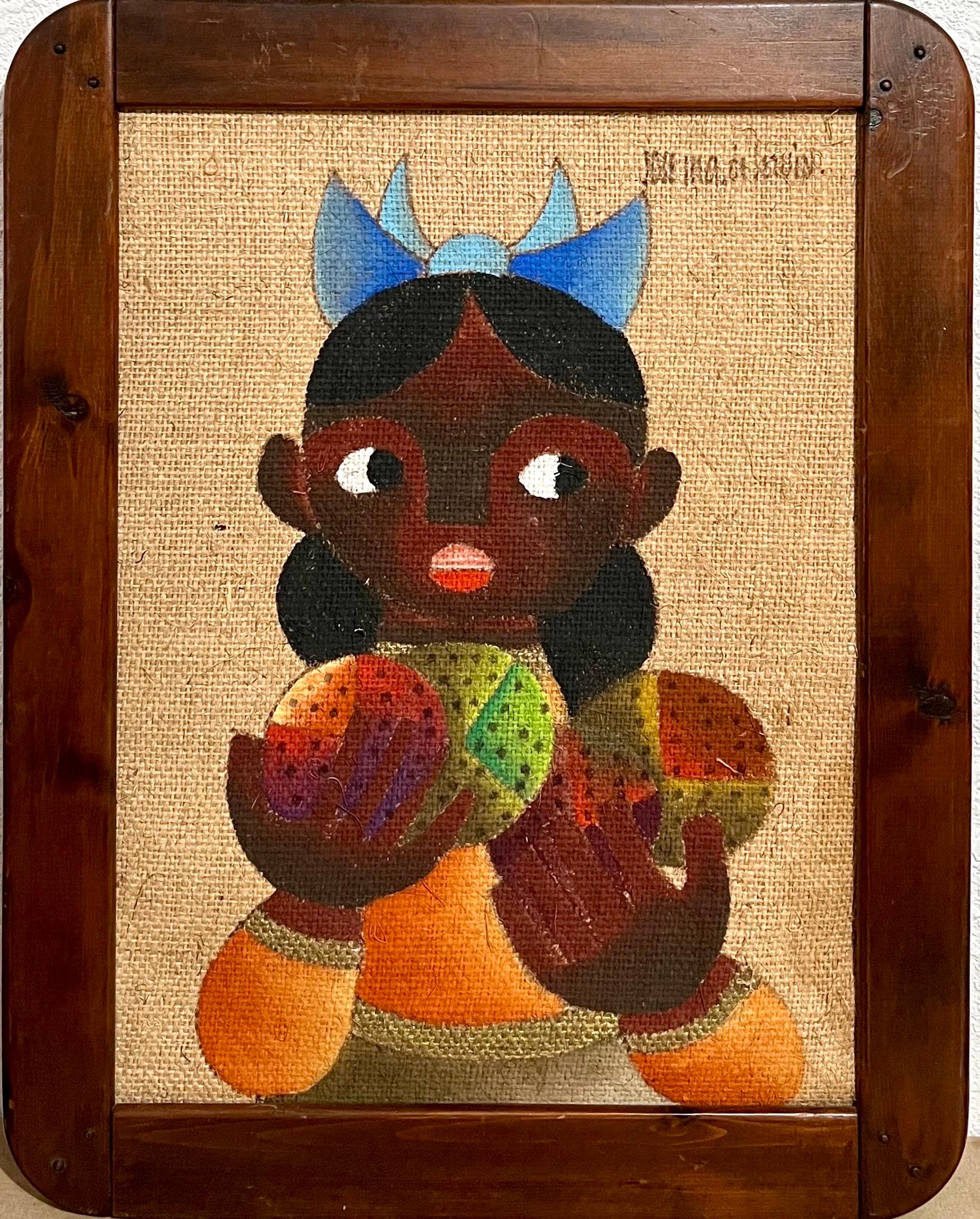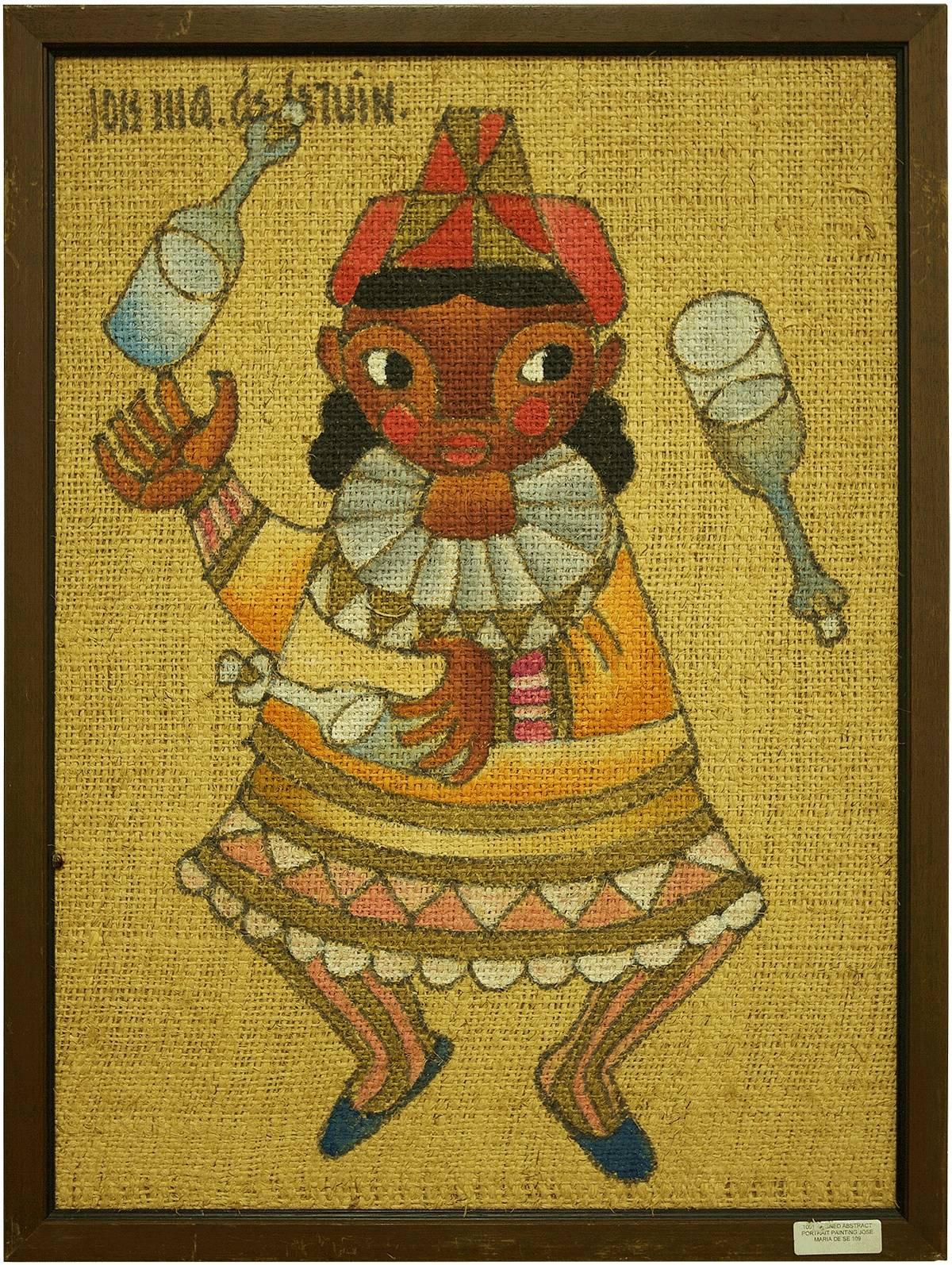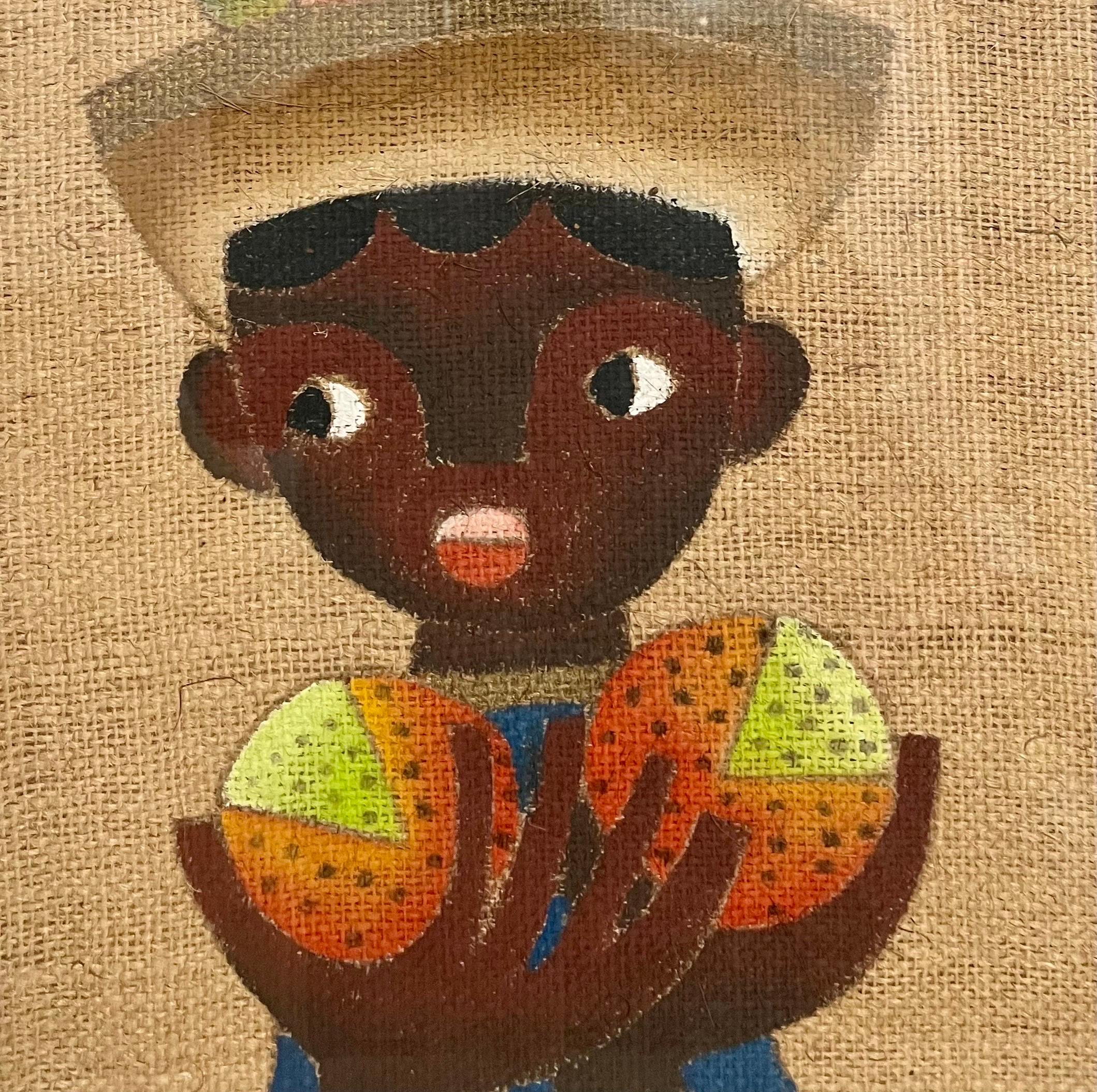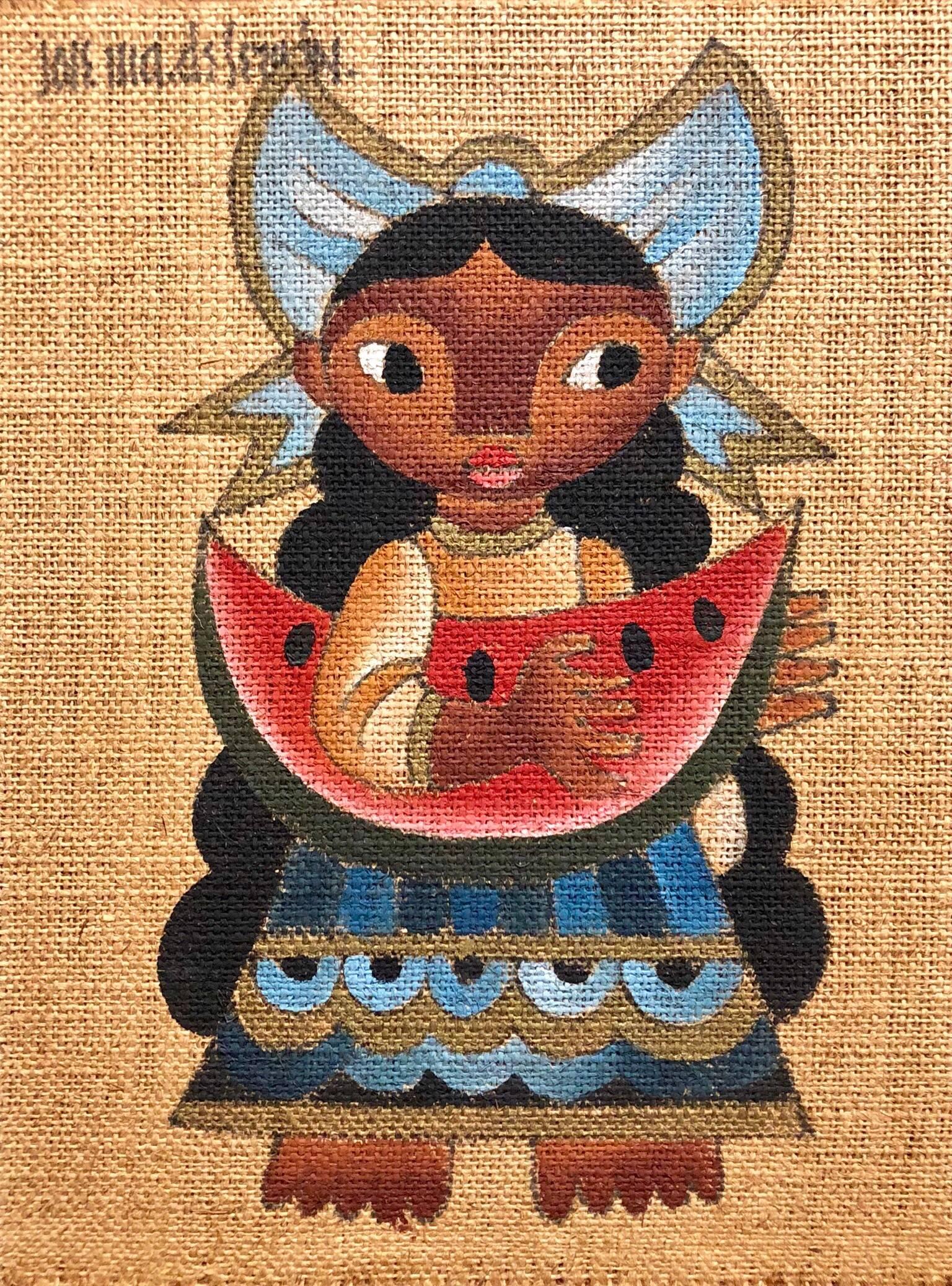Items Similar to "Mother of Cajamarca, " Oil on Jute signed by Ernesto Gutierrez
Want more images or videos?
Request additional images or videos from the seller
1 of 8
Ernesto Gutierrez (b.1941)"Mother of Cajamarca, " Oil on Jute signed by Ernesto Gutierrez2002
2002
About the Item
"Mother of Cajamarca" is an original oil painting on jute by Ernesto Gutierrez. The artist signed the piece lower right. It depicts a mother in a white hat embracing her child.
48" x 38" art
58" x 48" frame
A leading Peruvian artist, Ernesto Gutierrez, was born in Lima, Peru, in 1941. His father was a Spaniard and his mother a descendant of the Incas.
Upon completion of his high school education, Gutierrez entered the School of Fine Arts in Lima, Peru, where in 1964 he received a Bachelor of Fine Arts Degree and was awarded a Gold Medal. Sponsored by the Brazilian government, Gutierrez received the Itamarti Scholarship and studied for two years (1966-67) at the Museum of Modern Art in Rio de Janeiro, while extensively exhibiting his works throughout the art centers of South America: Rio de Janeiro, Sao Paulo, Cordova, Santiago de Chile, Lima, etc. In 1971, Gutierrez was granted a Fulbright Scholarship and studied at the University of Wisconsin where in 1974 he received a Master of Fine Arts Degree.
Gutierrez has been influenced by both local artistic factors: Pre-Columbian forms, native-popular Peruvian art, and also by modern French masters, such as Cézanne, Gaugin and, to a certain extent, Matisse. He is not of the school that needs the art critic to explain pallid lines to uncomprehending viewers. The boldness of Gutierrez’s colors, shocking pink, chartreuse, mauve hues and the whole gamut of blues, purples and greens – sometimes underlined and emphasized by opposite colors, such as black, maize or even pure white, adds to their dramatic effect, creating almost sensual excitement. In some of his paintings, Gutierrez assumes a cubist-realist simplification of forms and volumes and a precise rendering of surfaces. Gutierrez’s sensibility strikes as essentially Spanish while his inspiration derives from his Inca heritage, Peruvian landscapes and folklore.
- Creator:Ernesto Gutierrez (b.1941) (1941, Peruvian)
- Creation Year:2002
- Dimensions:Height: 58 in (147.32 cm)Width: 48 in (121.92 cm)
- Medium:
- Movement & Style:
- Period:
- Condition:
- Gallery Location:Milwaukee, WI
- Reference Number:
About the Seller
4.9
Platinum Seller
These expertly vetted sellers are 1stDibs' most experienced sellers and are rated highest by our customers.
Established in 1966
1stDibs seller since 2017
390 sales on 1stDibs
Typical response time: 1 hour
- ShippingRetrieving quote...Ships From: Milwaukee, WI
- Return PolicyA return for this item may be initiated within 14 days of delivery.
More From This SellerView All
- "Rosita Vendiendo Sombreros, Huancayo, " Oil on Jute signed by Ernesto GutierrezBy Ernesto Gutierrez (b.1941)Located in Milwaukee, WI"Rosita Vendiendo Sombreros, Huancayo" is an original oil painting on jute by Ernesto Gutierrez. It depicts a woman in white and blue selling hats. The artist signed the piece lower ...Category
Early 2000s Contemporary Figurative Paintings
MaterialsJute, Oil
- "Madre Joven (Young Mother), " Oil Painting on Jute signed by Ernesto GutierrezBy Ernesto Gutierrez (b.1941)Located in Milwaukee, WI"Madre Joven (Young Mother)" is an original oil painting on jute by Ernesto Gutierrez. The artist signed the piece lower right. It depicts a woman cradling her child. 22" x 20" art...Category
Early 2000s Contemporary Figurative Paintings
MaterialsJute, Oil
- "Mujer de Cajamarca, " Oil Painting on Jute signed by Ernesto GutierrezBy Ernesto Gutierrez (b.1941)Located in Milwaukee, WI"Mujer de Cajamarca" is an original oil painting on jute by Ernesto Gutierrez. The artist signed the piece in the lower right. It depicts a woman seated in front of an archway. 16"...Category
Early 2000s Contemporary Figurative Paintings
MaterialsJute, Oil
- "Vendedora de Sombreros, " Oil Painting on Jute signed by Ernesto GutierrezBy Ernesto Gutierrez (b.1941)Located in Milwaukee, WI"Vendedora de Sombreros" is an original oil painting on jute by Ernesto Gutierrez. The artist signed the piece lower right. It depicts a woman selling hats. 45" x 35" art 55" x 45"...Category
Early 2000s Contemporary Figurative Paintings
MaterialsJute, Oil
- "Dora Y Su Bebe, " an Oil on Jute Canvas signed by Ernesto GutierrezBy Ernesto Gutierrez (b.1941)Located in Milwaukee, WI"Dora Y Su Bebe" is Peruvian artist Ernesto Gutierrez's 2001 oil on jute canvas. 20" x 20" art 29" x 31" framed Ernesto Gutierrez was born in Lima, Peru in 1939, his father a Spani...Category
Early 2000s Contemporary Figurative Paintings
MaterialsJute, Oil
- "Ferria De Sombreros (The Hat Market), " Oil on Jute by Ernesto GutierrezBy Ernesto Gutierrez (b.1941)Located in Milwaukee, WI"Feria De Sombreros (The Hat Market)" by Peruvian artist Ernesto Gutierrez is a 2008 oil on jute painting, signed lower right. 36" x 46" art 48" x 58" framed Ernesto Gutierrez was ...Category
Early 2000s Contemporary Figurative Paintings
MaterialsJute, Oil
You May Also Like
- Bluebird Spring garden setting large female figure soft warm Grey violet yellowBy Stephen BassoLocated in Brooklyn, NYThis is an oil painting on jute canvas mounted on a cradled wood board. It is signed and dated by the artist on reverse. The texture is rough yet dense with a strong balance of light...Category
2010s Outsider Art Figurative Paintings
MaterialsJute, Wood, Oil, Canvas
- Folk Art Mexican Girl Oil Painting on Burlap Charming Naive African American ArtBy Jose Maria de ServinLocated in Surfside, FLFramed 29 X 23 Image 18 X 24 The sweetness that characterizes the work of Mexican painter Jose Maria de Servin (1917-83) is a melancholy and placid one. While he worked in the most modern of styles, he adapted it to an anecdotal folk-art approach distinctly his own. When he was an infant, de Servin's family moved with him to Guadalajara. A city of history and culture, Guadalajara had a thriving artistic community with strong connections to Europe. His brothers Antonio and Miguel became artists as well, and in later years they worked collaboratively. As a teenager, de Servin studied at one of Mexico's Schools of Open-Air Painting, free art-teaching institutions sponsored by the government. Later de Servin became a pupil of the painter Chucho Reyes, known for his improvisational watercolor variations on traditional Mexican themes. This interest in imagery particular to Mexico would be of great significance to de Servin. De Servin also studied under the more traditional painter Jose Vizcarra. In the early 1930s de Servin joined the Pintores Jovenes de Jalisco, or Young Painters of Jalisco. An influence of critical importance to de Servin was Pablo Picasso. One of the originators of Cubism, the Spanish painter soon departed from its quasi-scientific and optical basis to create lively and humorous geometrical abstractions. It was this Cubism, personal and decorative, that de Servin adopted. His earliest Cubist works mimic Picasso, while during the second stage of his career, his works become smooth and polished, with an emphasis on gentle surface textures. After these cautious years, however, a rough boldness enters along with dominating colors of earth and sand. Modernists like de Servin were interested in exploring what they considered primitive artmaking styles. The adoption of a native manner and native themes is in keeping with Modernist tenets, as is the use of nontraditional materials. De Servin's portraits of peasants, large-eyed and simply rendered, recall children's drawings. The rough burlap ground contrasts with the playful imagery and delicate range of color. The figures, all children or child-like adults, are all curves and simple shapes arranged harmoniously. De Servin's cubism is free from grotesquerie as it celebrates the simplicity of its subjects. De Servin worked with the social-realist Jose Orozco on several large mural commissions in Guadalajara, including one at the Legislative Palace. While their styles were dissimilar, both made use of Mexican imagery to glorify the common people. A sought-after muralist in his own right, de Servin brought the rich colors and endearing characters of his panels to his larger-scale work. For 15 years, de Servin taught summer art classes at the University of Arizona. His career was marked by many one-man shows, both in North America and Europe. In recent years, his striking style has attracted increased notice from critics and the public. His style is a unique conglomerate of tradition, history, legends, heroes, old customs and folklore. It is a self-standing style, recognizable, cheerful, whimsical and a happy creation. Naïve art is any form of visual art that is created by a person who lacks the formal education and training that a professional artist undergoes (in anatomy, art history, technique, perspective, ways of seeing). Unlike folk art, naïve art does not necessarily evince a distinct cultural context or tradition. Naïve art is recognized, and often imitated, for its childlike simplicity and frankness. Paintings of this kind typically have a flat rendering style with a rudimentary expression of perspective. One particularly influential painter of "naïve art" was Henri Rousseau (1844–1910), a French Post-Impressionist who was discovered by Pablo Picasso. Naïve art is often seen as outsider art that is by someone without formal (or little) training or degree. While this was true before the twentieth century, there are now academies for naïve art. Naïve art is now a fully recognized art genre, represented in art galleries worldwide. Museums devoted to naïve art now exist in Kecskemét, Hungary; Riga, Latvia; Jaen, Spain; Rio de Janeiro, Brasil; Vicq France and Paris. "Primitive art" is another term often applied to art by those without formal training, but is historically more often applied to work from certain cultures that have been judged socially or technologically "primitive" by Western academia, such as Native American, sub saharan African or Pacific Island art (see Tribal art). This is distinguished from the self-conscious, "primitive" inspired movement primitivism. Another term related to (but not completely synonymous with) naïve art is folk art. There also exist the terms "naïvism" and "primitivism" which are usually applied to professional painters working in the style of naïve art (like Paul Gauguin, Mikhail Larionov, Paul Klee). At all events, naive art can be regarded as having occupied an "official" position in the annals of twentieth-century art since - at the very latest - the publication of the Der Blaue Reiter, an almanac in 1912. Wassily Kandinsky and Franz Marc, who brought out the almanac, presented 6 reproductions of paintings by le Douanier' Rousseau (Henri Rousseau), comparing them with other pictorial examples. However, most experts agree that the year that naive art was "discovered" was 1885, when the painter Paul Signac became aware of the talents of Henri Rousseau and set about organizing exhibitions of his work in a number of prestigious galleries. The Earth Group (Grupa Zemlja) were Croatian artists, architects and intellectuals active in Zagreb from 1929 to 1935. The group included the painters Krsto Hegedušić, Edo Kovačević, Omer Mujadžić, Kamilo Ružička, Ivan Tabaković, and Oton Postružnik, the sculptors Antun Augustinčić, Frano Kršinić, and the architect Drago Ibler. A term applied to Yugoslav (Croatian) naive painters working in or around the village of Hlebine, near the Hungarian border, from about 1930. Some of the best known naive artists are Dragan Gaži, Ivan Generalić, Josip Generalić, Krsto Hegedušić, Mijo Kovačić, Ivan Lacković-Croata, Franjo Mraz, Ivan Večenaj and Mirko Virius. Camille Bombois (1883–1970) Ferdinand Cheval, known as 'le facteur Cheval' (1836–1924) Henry Darger (1892–1973) L. S. Lowry (1887–1976) Grandma Moses, Anna Mary Robertson (1860–1961) Nikifor (1895–1968) Poland, Horace Pippin (1888–1946) Jon Serl (1894-1993) United States Alfred Wallis (1855–1942) Scottie Wilson (1890–1972) Gesner Abelard...Category
Mid-20th Century Folk Art Figurative Paintings
MaterialsBurlap, Oil
- Folk Art Mexican Girl, Circus Clown JugglerBy Jose Maria de ServinLocated in Surfside, FLThe sweetness that characterizes the work of Mexican painter Jose Maria de Servin (1917-83) is a melancholy and placid one. While he worked in the most modern of styles, he adapted i...Category
Mid-20th Century Folk Art Figurative Paintings
MaterialsBurlap, Oil
- Folk Art Mexican Boy Oil Painting on Burlap Charming Naive African American ArtBy Jose Maria de ServinLocated in Surfside, FLFramed 29 X 23 Image 18 X 24 The sweetness that characterizes the work of Mexican painter Jose Maria de Servin (1917-83) is a melancholy and placid one. While he worked in the most modern of styles, he adapted it to an anecdotal folk-art approach distinctly his own. When he was an infant, de Servin's family moved with him to Guadalajara. A city of history and culture, Guadalajara had a thriving artistic community with strong connections to Europe. His brothers Antonio and Miguel became artists as well, and in later years they worked collaboratively. As a teenager, de Servin studied at one of Mexico's Schools of Open-Air Painting, free art-teaching institutions sponsored by the government. Later de Servin became a pupil of the painter Chucho Reyes, known for his improvisational watercolor variations on traditional Mexican themes. This interest in imagery particular to Mexico would be of great significance to de Servin. De Servin also studied under the more traditional painter Jose Vizcarra. In the early 1930s de Servin joined the Pintores Jovenes de Jalisco, or Young Painters of Jalisco. An influence of critical importance to de Servin was Pablo Picasso. One of the originators of Cubism, the Spanish painter soon departed from its quasi-scientific and optical basis to create lively and humorous geometrical abstractions. It was this Cubism, personal and decorative, that de Servin adopted. His earliest Cubist works mimic Picasso, while during the second stage of his career, his works become smooth and polished, with an emphasis on gentle surface textures. After these cautious years, however, a rough boldness enters along with dominating colors of earth and sand. Modernists like de Servin were interested in exploring what they considered primitive artmaking styles. The adoption of a native manner and native themes is in keeping with Modernist tenets, as is the use of nontraditional materials. De Servin's portraits of peasants, large-eyed and simply rendered, recall children's drawings. The rough burlap ground contrasts with the playful imagery and delicate range of color. The figures, all children or child-like adults, are all curves and simple shapes arranged harmoniously. De Servin's cubism is free from grotesquerie as it celebrates the simplicity of its subjects. De Servin worked with the social-realist Jose Orozco on several large mural commissions in Guadalajara, including one at the Legislative Palace. While their styles were dissimilar, both made use of Mexican imagery to glorify the common people. A sought-after muralist in his own right, de Servin brought the rich colors and endearing characters of his panels to his larger-scale work. For 15 years, de Servin taught summer art classes at the University of Arizona. His career was marked by many one-man shows, both in North America and Europe. In recent years, his striking style has attracted increased notice from critics and the public. His style is a unique conglomerate of tradition, history, legends, heroes, old customs and folklore. It is a self-standing style, recognizable, cheerful, whimsical and a happy creation. Naïve art is any form of visual art that is created by a person who lacks the formal education and training that a professional artist undergoes (in anatomy, art history, technique, perspective, ways of seeing). Unlike folk art, naïve art does not necessarily evince a distinct cultural context or tradition. Naïve art is recognized, and often imitated, for its childlike simplicity and frankness. Paintings of this kind typically have a flat rendering style with a rudimentary expression of perspective. One particularly influential painter of "naïve art" was Henri Rousseau (1844–1910), a French Post-Impressionist who was discovered by Pablo Picasso. Naïve art is often seen as outsider art that is by someone without formal (or little) training or degree. While this was true before the twentieth century, there are now academies for naïve art. Naïve art is now a fully recognized art genre, represented in art galleries worldwide. Museums devoted to naïve art now exist in Kecskemét, Hungary; Riga, Latvia; Jaen, Spain; Rio de Janeiro, Brasil; Vicq France and Paris. "Primitive art" is another term often applied to art by those without formal training, but is historically more often applied to work from certain cultures that have been judged socially or technologically "primitive" by Western academia, such as Native American, sub saharan African or Pacific Island art (see Tribal art). This is distinguished from the self-conscious, "primitive" inspired movement primitivism. Another term related to (but not completely synonymous with) naïve art is folk art. There also exist the terms "naïvism" and "primitivism" which are usually applied to professional painters working in the style of naïve art (like Paul Gauguin, Mikhail Larionov, Paul Klee). At all events, naive art can be regarded as having occupied an "official" position in the annals of twentieth-century art since - at the very latest - the publication of the Der Blaue Reiter, an almanac in 1912. Wassily Kandinsky and Franz Marc, who brought out the almanac, presented 6 reproductions of paintings by le Douanier' Rousseau (Henri Rousseau), comparing them with other pictorial examples. However, most experts agree that the year that naive art was "discovered" was 1885, when the painter Paul Signac became aware of the talents of Henri Rousseau and set about organizing exhibitions of his work in a number of prestigious galleries. The Earth Group (Grupa Zemlja) were Croatian artists, architects and intellectuals active in Zagreb from 1929 to 1935. The group included the painters Krsto Hegedušić, Edo Kovačević, Omer Mujadžić, Kamilo Ružička, Ivan Tabaković, and Oton Postružnik, the sculptors Antun Augustinčić, Frano Kršinić, and the architect Drago Ibler. A term applied to Yugoslav (Croatian) naive painters working in or around the village of Hlebine, near the Hungarian border, from about 1930. Some of the best known naive artists are Dragan Gaži, Ivan Generalić, Josip Generalić, Krsto Hegedušić, Mijo Kovačić, Ivan Lacković-Croata, Franjo Mraz, Ivan Večenaj and Mirko Virius. Camille Bombois (1883–1970) Ferdinand Cheval, known as 'le facteur Cheval' (1836–1924) Henry Darger (1892–1973) L. S. Lowry (1887–1976) Grandma Moses, Anna Mary Robertson (1860–1961) Nikifor (1895–1968) Poland, Horace Pippin (1888–1946) Jon Serl (1894-1993) United States Alfred Wallis (1855–1942) Scottie Wilson (1890–1972) Gesner Abelard...Category
Mid-20th Century Folk Art Figurative Paintings
MaterialsBurlap, Oil
- Folk Art Mexican Girl with Watermelon Oil Painting on BurlapBy Jose Maria de ServinLocated in Surfside, FLThe sweetness that characterizes the work of Mexican painter Jose Maria de Servin (1917-83) is a melancholy and placid one. While he worked in the most modern of styles, he adapted i...Category
Mid-20th Century Folk Art Figurative Paintings
MaterialsBurlap, Oil
- Folk Art Mexican Girl "Emborrachate" Oil Painting on BurlapBy Jose Maria de ServinLocated in Surfside, FLThe sweetness that characterizes the work of Mexican painter Jose Maria de Servin (1917-83) is a melancholy and placid one. While he worked in the most modern of styles, he adapted i...Category
Mid-20th Century Folk Art Figurative Paintings
MaterialsBurlap, Oil
Recently Viewed
View AllMore Ways To Browse
Peru Art
Folklore Art
Signed Cezanne
Peruvian Artist
American Mother And Child Painting
Mother And Child Figurative Painting
Modern Painting Mother And Child
Matisse Colors Signed
Lima Peru
Art From Rio De Janeiro
Chartreuse Sign
Paintings By Peruvian Artists
Peruvian Oil Painting
Hue Folk
Columbian Painting
Peruvian School
Shocking Pink
Inca Art
